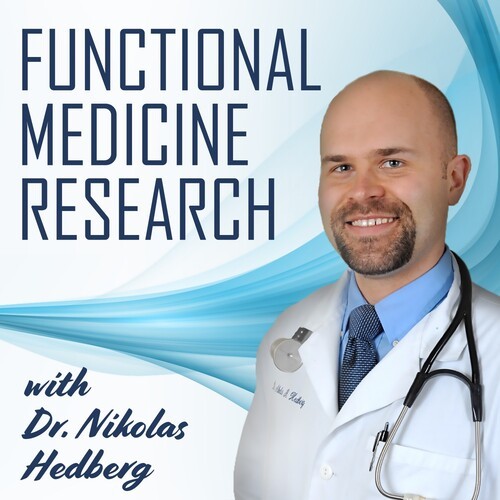
Berberine: Benefits and Clinical Applications
Functional Medicine Research with Dr. Nikolas Hedberg, DC
Episode · 1 Play
Episode · 1 Play · 20:53 · Aug 25, 2022
About
Berberine is an isoquinolone alkaloid that is bitter and bright golden yellow in color. It is derived mainly from the roots, stems and rhizomes of plants such as Coptis chinensis (Chinese golden thread), Hydrastis canadensis (goldenseal), Berberis aquifolium (Oregon grape), and Berberis vulgaris (barberry). It has been used for thousands of years in traditional Chinese and Ayurvedic medicine and is generally considered safe, though it should be avoided during pregnancy and lactation. Berberine Click here to learn more about the Hedberg Institute Membership. Gastrointestinal side effects may occur due to berberine's impact on bowel motility. These include abdominal pain, distention, nausea, vomiting, and constipation. Side effects appear to be dose dependent, with increased symptoms such as low blood pressure, dyspnea, and flu-like symptoms at higher doses. Berberine is commonly used as an antibacterial, antiviral, antimicrobial, antifungal, and antihyperlipidemic agent. The many therapeutic applications of berberine are due to its antioxidant and anti-inflammatory properties, making it one of the top supplements of choice in clinical practice. It has traditionally been used for gastrointestinal related issues as well as issues involving liver dysfunction, digestive complaints, blood sugar regulation, inflammation, and infectious diseases. While berberine has exhibited a bioavailability of <1%, the metabolites of berberine have demonstrated increased absorption in the system. These metabolites contribute to the widespread impact observed from the use of berberine on liver, kidney, muscle, lung and brain. Gastrointestinal Support Chen at el (2015) conducted a randomized clinical trial that demonstrated the usefulness of using berberine in treating patients with IBS-D. Berberine (400 mg delivered twice daily) reduced the frequency of diarrhea, abdominal pain, and the urgency of defecation after 8 weeks. They concluded that berberine was well tolerated and was beneficial in treating IBS-D. They also noted that those in the berberine group showed improvements in their depression and anxiety scores and in their IBS quality of life scores. Berberine has been shown to induce structural and compositional changes in the gastrointestinal microbiota. These changes affect the metabolites dependent on the microbes such as trimethylamine N-oxide (TMAO), short chain fatty acids (SCFAs), bile acids (BAs), branched-chain amino acids (BCAAs), and aromatic amino acids (AAAs). Yao et al confirmed berberine's gut modulatory ability in their 2020 study using rats. They showed that berberine caused changes in the GI microbiota that included increased beneficial microbes in the phylum Bacteroidetes and the family Lactobacillaceae. An increase in Lactobacillaceae was also observed to be negatively associated with the risk of Type 2 Diabetes (T2D). A decrease in potentially pathogenic microbes in the phylum Proteobacteria and Verrucomicrobia was noted along with a decrease in aromatic amino acids (AAAs). The authors concluded that berberine was able to modulate the gut microbiota of the rats in the study. This led to improved glucose tolerance and the alleviation of symptoms associated with T2D, such as abnormal glucose and lipid levels. They recommended the use of berberine in the treatment of T2D in rats. Glucose and Lipid Regulation Berberine is useful in conditions associated with metabolic diseases and atherosclerosis due to its ability to decrease inflammation, improve glucose and lipid metabolism, and improve energy homeostasis, making it beneficial as a treatment option for those with T2D. The hypoglycemic effects of berberine have been shown comparable to Metformin. An important mechanism of action that occurs with the use of berberine is the activation of AMPK. Drugs such as Metformin work by stimulating this AMPK pathway. Turner et al (2008) concluded, in their study on IR mice,
20m 53s · Aug 25, 2022
© 2022 Blubrry (OG)